Accepted Scientific Name: Oroya peruviana Britton & Rose
3: 102. 1922 [12 Oct 1922]
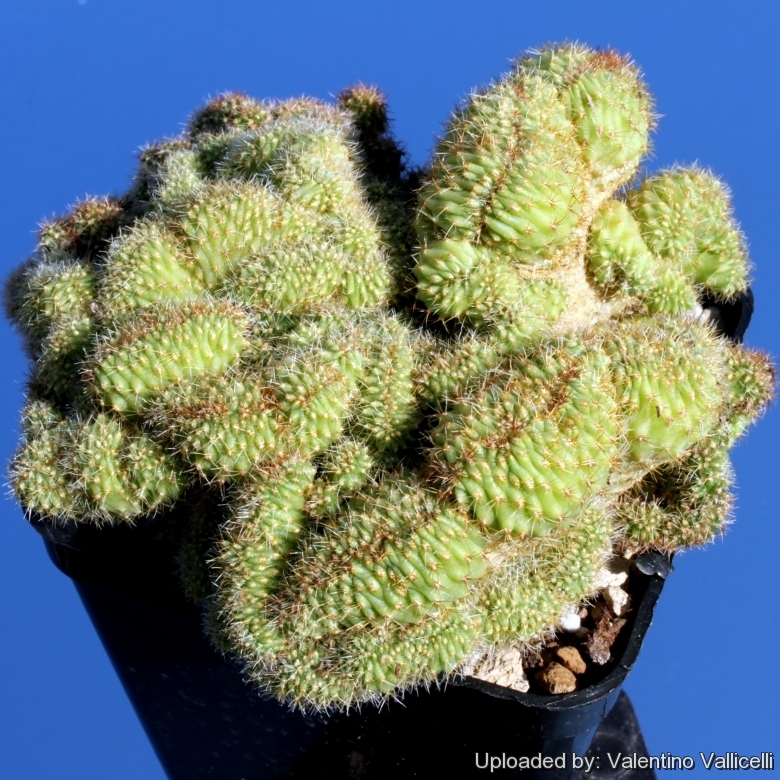
Oroya peruviana f. cristata Photo by: Valentino Vallicelli
Origin and Habitat: Garden origin (Nursery produced cultivar)
Synonyms:
See all synonyms of Oroya peruviana
back
Accepted name in llifle Database:Oroya peruviana Britton & Rose3: 102. 1922 [12 Oct 1922]Synonymy: 28
back
Description: This is the nice crested form of Oroya peruvianaSN|1494]]SN|1494]], a small cactus miniature that will slowly forms tangled groups up to 20 cm in diameter.
Habit: The standard Oroya peruvianaSN|1494]]SN|1494]] is an extremely variable slow-growing perennial cactus species that grows, as the Oreocereus do, in the high mountains of the Andes. It is (usually) solitary but may produce small clumps with age.
Root: Tuberous.
Stem: Fan-shaped, bright green to blue-green with obtuse ribs divided into low tubercles.
Areoles: Long, narrow 8 long, whitish, closely set, very woolly, on the extremity of a groove in the tip of tubercles.
Spines: Ranging in colour from pale yellow, to orangish, to coppery gold to brown with darker bases and reddish tips , barely distinguishable as centrals and radials.
Radial spines: 15 to 20, variable, more or less pectinated, slightly curved inward, unequal, the longer ones about 2 cm long (usually less than 1,5 cm long).
Central spines: Sometimes as many as 6, but often wanting, a little longer and stouter than the laterals and usually reddish-brown in colour.
Flowers: Small 1,5 to 2 cm long, bell to funnel-shaped, often very numerous, produced from young areoles, pink-orange-red with a whitish to lemon yellow centre.
Blooming season: Spring to summer.
Fruit: More or less spherical or short club shaped, hollow berries, slightly fleshy, yellow or reddish brown., and covered with small scale. Flowers remnants persistent.
Seeds: Helmet-shaped, reddish-brown to black, approx. 2 mm long.
Subspecies, varieties, forms and cultivars of plants belonging to the Oroya peruviana group
 Oroya peruviana Britton & Rose: is a variable species with (usually) solitary slow-growing flattened stem up to 20 cm in diameter. The spines are also variable, more or less pectinated and range in colour from pale yellow to brown.
Oroya peruviana Britton & Rose: is a variable species with (usually) solitary slow-growing flattened stem up to 20 cm in diameter. The spines are also variable, more or less pectinated and range in colour from pale yellow to brown. Oroya peruviana f. cristata hort.: crested form. Garden origin (Nursery produced cultivar)
Oroya peruviana f. cristata hort.: crested form. Garden origin (Nursery produced cultivar) Oroya peruviana var. depressa (Rauh & Backeb.) Rauh & Backeb. in Rauh: has very flattened (depressed) stem, growing slowly to 20 cm. across. Diastribution: Apurimac region (Totorabamba, Andahuaylas, Kishuara), Peru.
Oroya peruviana var. depressa (Rauh & Backeb.) Rauh & Backeb. in Rauh: has very flattened (depressed) stem, growing slowly to 20 cm. across. Diastribution: Apurimac region (Totorabamba, Andahuaylas, Kishuara), Peru. Oroya peruviana var. gibbosa F.Ritter: Plant with few spines and ribs notched and forming noticeable tubercles.
Oroya peruviana var. gibbosa F.Ritter: Plant with few spines and ribs notched and forming noticeable tubercles. Oroya peruviana var. minima Kníže: it is a freely offseting clone known in cultivation only. In age forms clump up to 15 cm in diameter with up to 100 heads (or more).
Oroya peruviana var. minima Kníže: it is a freely offseting clone known in cultivation only. In age forms clump up to 15 cm in diameter with up to 100 heads (or more). Oroya peruviana var. neoperuviana (Backeb.) Slaba: Up to about 40 cm. tall and 25 cm. wide, with 24-40 ribs, spines pectinated, yellowish to straw-yellow. Flowers orange-red, produced in a ring around the crown of the plant in spring.
Oroya peruviana var. neoperuviana (Backeb.) Slaba: Up to about 40 cm. tall and 25 cm. wide, with 24-40 ribs, spines pectinated, yellowish to straw-yellow. Flowers orange-red, produced in a ring around the crown of the plant in spring.
Bibliography: Major references and further lectures
1) Edward Anderson “The Cactus family” Timber Press, Incorporated, 2001
2) James Cullen, Sabina G. Knees, H. Suzanne Cubey "The European Garden Flora Flowering Plants: A Manual for the Identification of Plants Cultivated in Europe, Both Out-of-Doors and Under Glass" Cambridge University Press, 11/Aug/2011
3) David R Hunt; Nigel P Taylor; Graham Charles; International Cactaceae Systematics Group. "The New Cactus Lexicon" dh books, 2006
4) N. L. Britton, J. N. Rose “The Cactaceae. Descriptions and Illustrations of Plants of the Cactus Family.” Volume 4, The Carnegie Institution of Washington, Washington 1923
5) Urs Eggli, Leonard E. Newton “Etymological Dictionary of Succulent Plant Names” Birkhäuser 2004.
6) William Taylor Marshall “Succulent Plants” Or., Sawyer's, 1945
7) Vera Higgins “The Study of Cacti” Blandford Press, 1946
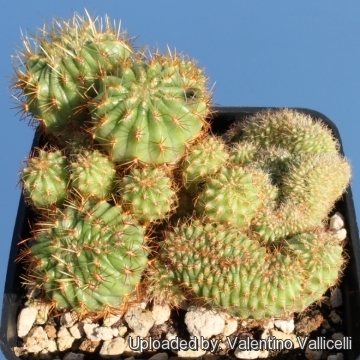 Oroya peruviana f. cristata Photo by: Valentino Vallicelli
Oroya peruviana f. cristata Photo by: Valentino Vallicelli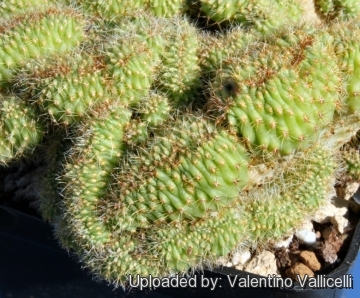 Oroya peruviana f. cristata Photo by: Valentino Vallicelli
Oroya peruviana f. cristata Photo by: Valentino Vallicelli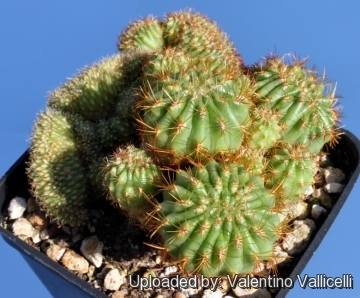 Summer. Photo by: Valentino Vallicelli
Summer. Photo by: Valentino Vallicelli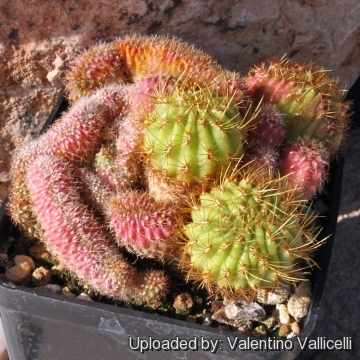 Winter. Photo by: Valentino Vallicelli
Winter. Photo by: Valentino Vallicelli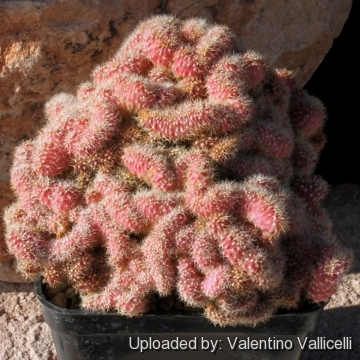 Oroya peruviana f. cristata Photo by: Valentino Vallicelli
Oroya peruviana f. cristata Photo by: Valentino VallicelliSend a photo of this plant.The gallery now contains thousands of pictures, however it is possible to do even more. We are, of course, seeking photos of species not yet shown in the gallery but not only that, we are also looking for better pictures than those already present.
Read More... Cultivation and Propagation: Although regarded as a choice and difficult this mountainous plant is not too difficult in a greenhouse, although grows quite slowly. It is sometime seen as a grafted plant but grows very well on its own roots too.
Soil: Use mineral well permeable mineral soil with little organic matter (peat, humus).
Exposure: The plant tolerates extremely bright situations but enjoys some shade during the hottest part of the day in summer.
Watering: Water sparingly from March till October (weekly during summertime, if the weather is sunny enough), with a little fertilizer added. Less or no water during cold winter months, or when night temperatures remain below 10° to prevent root loss. It is sensitive to overwatering (rot prone).
Fertilization: Feeding may not be necessary at all if the compost is fresh then, feed in summer only if the plant hasn't been repotted recently. Do not feed the plants from September onwards as this can cause lush growth which can be fatal during the darker cold months.
Hardiness: Oroya peruvianaSN|1494]]SN|1494]] is one of the most cold-tolerant South American species. It can grow outdoors and is hardy to -15° C or less.
Crested growth: Unlike 'monstrose' varieties of plants, where the variation from normal growth is due to genetic mutation, crested growth can occur on normal plants. Sometimes it's due to variances in light intensity, or damage, but generally the causes are unknown. A crested plant may have some areas growing normally, and a cresting plant that looks like a brain, may revert to normal growth for no apparent reason. If you have any of the crested part left you need to remove the normal growth and leave the crested part behind this will need to be done regularly.
Propagation: Grafting or cuttings. Plants are usually grafted onto column-shaped cacti but proved to be able to produce their own roots if degrafted. Cuttings will take root in a minimum temperature of 20° C (but better in hot weather). Cuttings of healthy shoots can be taken in the spring and summer. Cut the stem with a sharp, sterile knife, leave the cutting in a warm, dry place for a week or weeks (depending on how thick the cutting is) until a callus forms over the wound. Once the callus forms, the cutting may be inserted in a container filled with firmed cactus potting mix topped with a surface layer of coarse grit. They should be placed in the coarse grit only; this prevents the cut end from becoming too wet and allows the roots to penetrate the rich compost underneath. The cuttings should root in 2 to 6 weeks. Large crested piece must be placed on the soil surface without burying the plant base down in the soil.















